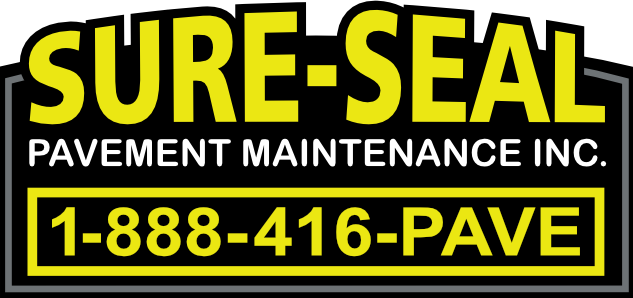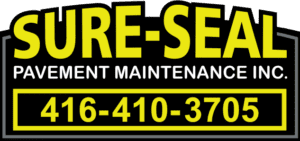Pavement line marking is an essential factor in traffic management to enhance the safety of motorists and pedestrians. Across the GTA, there are various
line markings used to direct the flow of traffic, reduce the risk of accidents, and provide guidance on the moving and parking of vehicles. There are longitudinal markings, traverse markings, hazard markings, block markings, and arrow markings, all with their own purpose and distinctive design.
Longitudinal Line Markings
The yellow and white line markings, like those seen on roadways between traffic lanes, guide motorists on which direction to drive and when it’s safe to change lanes. Yellow painted lines are a non-dimensional barrier intended to keep vehicles travelling in one specific “lane”. The white lines indicate to motorists not to cross into an area. The structure of the lines differ in traffic management.
- Continuous lines: These white- and yellow-coloured lines on a roadway indicate it is unsafe to pass another vehicle or to venture on the other side of the line. They are also used in parking lots for safe traffic flow.
- Broken lines: A broken line to the left of a vehicle on a roadway allows for passing if the coming lane is clear or may signify the current lane is ending if present in a construction zone or exit lane.
- Double yellow lines: A double yellow line alerts motorists not to pass the vehicle ahead of them due to an upcoming obstacle or an unsafe passing lane.
- Lane reduction lines: These broken lines are used only to notify of an upcoming end to a lane on a roadway to allow for traffic management.

Transverse Line Markings
Transverse line marking are used in situations where an immediate action is required by the motorist. Transverse line markings that cross an area of the pavement can exist as a broken line, a single line, or a double line marking.
- Stop lines: A wide traverse line in white paint at the end of a parking lot or at an intersection indicates a full-stop of the vehicle is necessary to prevent an accident or collision with another vehicle.
- Crosswalks: Painted lines on the pavement depicting a pedestrian crossing zone may appear as white or yellow straight or diagonal lines across a roadway. These are applied to reduce the risk of injuries and collisions.
- Yield lines: For enhanced traffic management on a roadway or in a parking lot, yield lines are painted on the pavement. These resemble a shark’s tooth and indicate pedestrians or conflicting traffic have the right-of-way.
- Speed limit markings: Similar to the standing signs, speed limit markings indicate the legal travelling speed of a vehicle in a parking lot or within a zone. A “SLOW” painted marking may also be applied to the pavement to reduce vehicular speeds.
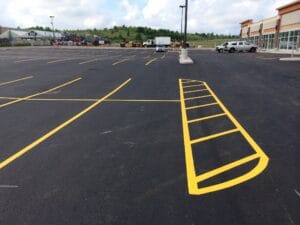
Hazard Markings
Pavement markings that indicate a hazardous conditions or potential for such are accompanied by standing signs in the immediate area. This form of traffic management reduces the risk of collisions and accidents.
- Chevron markings: A reversed V-shape marking signifies an upcoming obstacle, hazard, or barrier as seen with a division of road lanes or shift in traffic flow. Known as chevon lines, these markings can be used in parking lots to reduce potential accidents.
- Diagonal markings: Whether in yellow or white-coloured paint, these lines are applied to an area where no parking or stopping by motorists is allowed. Diagonal lines are used to ensure emergency vehicles and\or delivery trucks have priority access to a building.
- Hatch markings: Not to be confused with pedestrian crossing lines, hatch markings designate a zone of no-entry or crossing areas. Applied in a diagonal pattern, these yellow or white lines separate traffic enhancing the safety of the area.

Block Markings
Block markings are commonly used on roadways to extend the continuity of a designated line or marking across an intersection or access road. In parking lots, block markings are used to manage the parking of vehicles and to control foot traffic.
- Parking stall markings: With line markings for parking lots, having precise measurements between parking stalls can improve the flow of traffic and the safety measures. Designated parking stalls can also involve handicap, family, and/or expectant mother parking slots close to the entrance of the building.
- Loading zone markings: Commercial businesses need specialized loading zone markings for the accessibility for all deliveries. These areas can be designated with block markings to deter the entry or stopping of regular vehicles in the zone. The markings are for both safety reasons and logistic reasons.
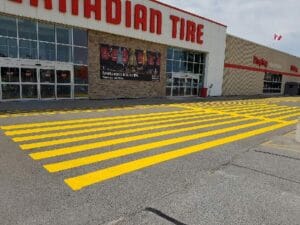
Arrow Markings
Arrows are a common method of directing the flow of traffic on a roadway or within a parking lot. They are used to increase vehicle and pedestrian safety through traffic management.
- Directional arrows: By guiding traffic flow, directional arrows give order to a parking lot by helping vehicles maneuver safely in, through, and out of the property.
- Lane direction arrows: The arrows may be applied to lanes separated by a yellow solid line or can be used for a one-way directional flow of traffic.
- Turn arrows: Application of turn arrows in a parking lot, or on a roadway, are a safety measure under traffic management and control. These arrows are used to indicate which lane is designated for turning at intersections.
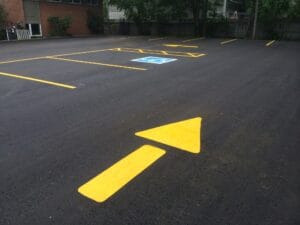
Enhance the Safety of Your Property or Access Road with Sure-Seal’s Line Marking Services
Line painting removal and application are part of
Sure-Seal Pavement Maintenance Inc.’s
parking lot line marking services. From warehouses, airports, and commercial and residential parking lots, we use only the highest-grade products, advanced technology, and safety measures to produce long-lasting results.
We perform routine property maintenance that includes
parking lot striping, filling in potholes,
sealing cracks,
removing/replacing asphalt, and painting pavement markings. Our work is backed by extensive warranties for materials and labour.
Contact us today to discuss how we can help improve the safety of your parking lot or access road.



